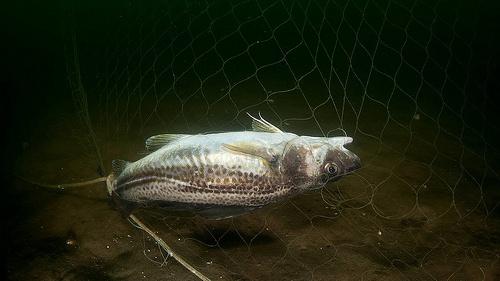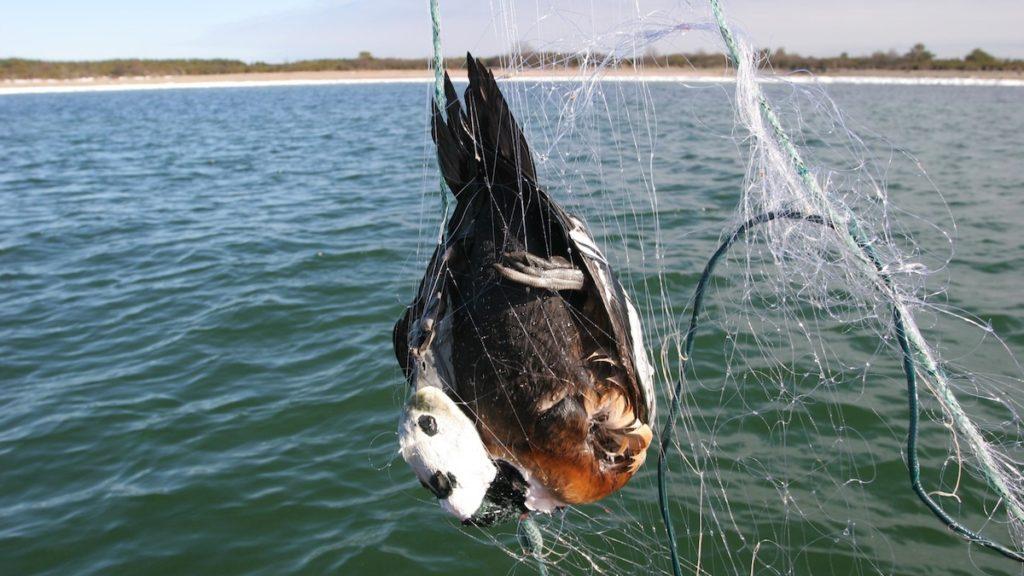Bycatch
By-catch, also known as unwanted catch, is the action of catching other species than the ones targeted by fishing. Lost fishing gear, such as gillnets, kill fish unnecessarily and are also dangerous for birds and mammals like harbour porpoises or seals. This is known as “ghost fishing”.
Fish
Discarding fish is a waste of marine resources and should be reduced to the lowest level and ultimately eliminated, if possible. Under the current EU Common Fisheries Policy reform, discard reduction plays a relevant role.
Discards and by-catch rates of fish in the Baltic fisheries are not yet fully investigated, but some studies indicate that the major Baltic commercial fisheries for cod, herring, and sprat have low discards and by-catch rate compared to other areas, such as the North Sea. Discard estimates for the two Baltic cod stocks are available since 1996 when the sampling was commenced. The western and eastern cod discards have fluctuated during the period of 1996-2007 between 5.0-26.6 and 3.7-23.3 million of mainly juvenile cod individuals, respectively. However, the discard estimates are relatively uncertain (ICES 2008a).
The HELCOM Baltic Sea Action Plan urges that all caught species and by-catch that cannot be released alive or without injuries should be landed and reported by 2012. Furthermore, it urges the adoption of measures to minimize by-catch of undersized fish and non-targeted species by 2012.
Fishing activities can positively affect the seabird community through the discarding of unwanted catch and fish offal. There are estimates that over 50% of the fish offal discarded in the Baltic marine area will be consumed by seabirds (ICES, 2000).

Birds and Mammals
Several studies have shown that the set net (gillnet) fisheries in the Baltic Sea can in certain places cause high bird mortality. The by-catch problem is of special relevance where gillnet fisheries are exercised in the areas with high concentrations of resting, moulting or wintering seabirds. The conflicts are usually seasonal.
Piscivorous birds (divers, grebes, mergansers, auks, cormorants) and benthophagic ducks may get entangled and die in fishing gear. Set nets also cause mortality of long-tailed ducks (Clangula hyemalis), velvet scoters (Melanitta fusca), eiders (Somateria mollissima), and black scoters (Melanitta nigra). There are also reports of guillemot and razorbill (Alca torda) mortality in the driftnet fishery for salmon (HELCOM, 2003).
The current information on the abundance of harbour porpoise (Phocoena phocoena) provides evidence for a population size of fewer than 250 mature animals in the Baltic Sea subpopulation. Therefore, any loss of porpoises to fisheries in the Baltic marine area may be too much to sustain the population. In the Swedish part of the Skagerrak and Kattegat the annual by-catch rate of harbour porpoises was estimated to amount to 25 porpoises in bottom trawls and 89 porpoises in gillnets, trammel nets and pelagic trawls (ASCOBANS 2008). In the German (Siebert et al. 2006) waters most of the 105 recorded by-caught porpoises between the years 1990-2001, were reported from bottom-set gillnet fisheries or stranded with characteristic net marks. A total of 45 by-caught animals were reported from Polish waters between 1990 and 1999 (Skóra & Kuklik 2003). In Latvia, two porpoises were found entangled in fishing nets in the Gulf of Riga in October 2003 and in January 2004, respectively (ASCOBANS 2004).
It has been estimated that at least 300 grey seals, 80 ringed seals and 7–8 harbour seals are captured as by-catch annually in the Baltic Sea (ICES 1995). Further estimates are available for the Swedish Baltic Sea coastal fisheries where in total over 400 grey seals and 50 ringed seals were by-caught in 2001 (Lunneryd et al. 2005).

References
Alheit J., Möllmann C., Dutz J., Kornilovs G., Loewe P., Mohrholz V. and Wasmund N. 2005: Synchronous regime shifts in the Central Baltic and the North Sea in the late 1980s. — ICES Mar. Sci. J. 62: 1205–1215.
ASCOBANS 2004: Information on bycatch of harbour porpoises in Latvian waters 2003/2004. ASCOBANS Document AC11/Doc. 20(S). Available at: http://www.service-board.de/ascobans_neu/files/ac11-20.pdf
ASCOBANS 2008: Annual National Reports 2007 b) Sweden. Document AC15/Doc. 15(P). Available at: http://www.service-board.de/ascobans_neu/files/ac15-15b.pdf
Helander B. and Härkönen T. 1997: Säl och havsörn. Bottniska viken 1996 – årsrapport från den marina miljöövervakningen. pp. 21-23. Umeå Marina Forskningscentrum.
HELCOM 2003: The Baltic Marine Environment 1999–2002. Baltic Sea Environment Proceedings No. 87.
ICES 2000: Report of the Working Group on Ecosystem Effects of Fishing Activities. ICES CM 2000/ACME: 02. Ref.: ACFM+E.
ICES 2008: Overview report on Baltic Sea. Available at: http://www.ices.dk/committe/acom/comwork/report/2008/2008/8%2018%202%20Baltic%20ecosystem%20overview.pdf
Köster F.W., Möllmann C., Neuenfeldt S., Vinther M., St. John M.A., Tomkiewicz J., Voss R., Hinrichsen H.H., Kraus G. and Schnack D. 2003: Fish stock development in the Central Baltic Sea (1976-2000) in relation to variability in the physical environment. — ICES Mar. Sci. Symp. 219: 294-306.
Köster F.W. and Möllmann C. 2000a: Trophodynamic control by clupeid predators on recruitment success in Baltic cod? — ICES J. Mar. Sci. 57: 310-323.
Lunneryd S.G., Hemingsson M., Tärnlund S., Fjälling A. 2005: A voluntary logbook scheme as a method of monitoring the by-catch of seals in Swedish coastal fisheries. ICES CM 2005/X: 04, 5 pp.
Nilsson J., Andersson J., Karås P. and Sandström O. 2004: “Recruitment failure and decreasing catches of perch (Perca fluviatilis L.) and pike (Esox lucius L.) in the coastal waters of southeast Sweden” — Boreal Environment Research 9: 295-306.
Sandström A. and Karås P. 2002: Effects of eutrophication on young-of-the-year freshwater fish communities in coastal areas of the Baltic. — Env. Biol. Fish. 63: 89–101.
Siebert U., Gilles A., Lucke K., Ludwig M., Benke H., Kock K.H. and Scheidat M. 2006: A decade of harbour porpoise occurrence in German Waters – Analysis of aerial surveys, incidental sightings and strandings. — Journal of Sea Research 56: 65-80.
Skóra K.E. and Kuklik I. 2003: Bycatch as a potential threat to harbour porpoises (Phocoena phocoena) in Polish Baltic Waters. — NAMMCO Scientific Publication 5: 303–315.

